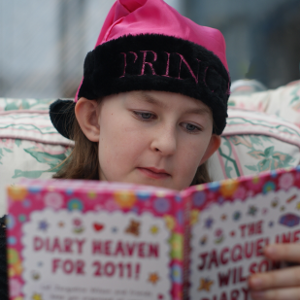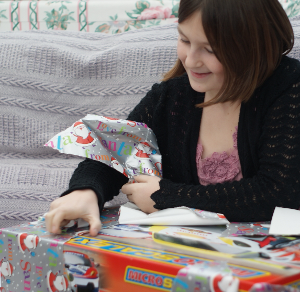
international symbol for diabetes
Diagnosed 29th December 2010
Feeling poorly
I had been off school sick in early December, away from my friends who I missed. But it was only a horrible cold and I was sick once or twice. It was nothing to worry about, soon I’d be okay and back at school again.
I’ve always been pretty rubbish at knowing when I needed to go to the toilet but it was getting worse. I was getting really, really, really thirsty and ended up downing pints of water to try and quench my thirst but nothing seemed to work. The more I drank the more I went to the toilet and I remember noticing that there was no colour at all to my wee. But I don’t remember this happening at school at all, which is strange seeing that I was there for two weeks after I was ill and the Doctors say that the early December illness probably caused the problem with my pancreas. Perhaps there’s a delay.
We broke up from school for the Christmas break. I love Christmas because I get to have fun decorating the Christmas tree and seeing all of my family and I’ve got lots of them to see. I love the celebrations, the family ones and the chocolate ones. We’re allowed to stay up later, things are more relaxed, we can snack on chocolates if meals are a little later than normal. When I wanted a drink I’d get it myself, I’d even have my favourite Fanta if there was some in the fridge. It was great.
After Christmas I went shopping with Mummy and before I went out I remember saying “can I take a bottle of water with me” and Mummy said “don’t bother we won’t be that long”. But I did need it, I knew I’d need it and I was right. Why didn’t she listen to me? We’d only been at the shops 5 minutes and I needed the toilet so I went into McDonalds and used theirs. After coming out I complained I was thirsty and asked “can I have a drink”. Mummy said “but then you’ll need the toilet again”. I didn’t get that drink.
We went into Iceland and I saw a pack of fruit juice and pleaded for them. “No”. “No”. “Alright then if you’re really that thirsty”. I opened it immediately after we’d paid for it and drank it. Then I asked for another. I didn’t get it.
At the Doctor’s Surgery
The next morning Mummy woke me up and told me I had to go to the Doctor’s at 10am. At the Doctor’s Mummy explained about the drinking and toilet visits. He pricked my finger and took some blood which he tested but he didn’t really say anything. There was lots of words, I didn’t understand any of them but I didn’t think it was serious as Doctors just give you medicine which you take for a while and then you’re better.
I heard the word ‘diabetes’. I think that’s the first time I heard the word directed at me. I thought about my Grandad who I knew had diabetes and I knew it just meant that he couldn’t quite eat as much cake as he’d like to. I didn’t know there were different types. The Doctor said he’d phone the hospital and they’d call us if needed.
After the Doctors I went to one of my friends to tell her that I might not be able to come to her party and I gave her the present I’d bought her. When I got back Daddy told me that I had to go to the hospital at 3pm.
At the Hospital
It was only the second time I’d been to Winchester hospital. I don’t remember the first time as I was only 1 second old – I was born there.
I wasn’t worried at all. Hospitals didn’t worry me.
Sophie’s Place seemed really friendly and so did the people. They measured my height and weight and sat me down in the childrens’ in-patients area where they took my blood pressure. It still didn’t seem very serious and I felt quite calm.
We went into a room and a nurse came to see us. She said she was very sorry but I had diabetes and I would need to take something called insulin. I didn’t know what it meant but it didn’t seem very serious. She asked if I had any questions.
“Will I have this for the rest of my life?”.
“Yes, I’m afraid you will”.
I started thinking that this might be serious. I felt gutted, worse than gutted, the rest of my life! I remember looking at Daddy who looked really sad.
They told me they needed to take some blood and then left. They seemed to be gone for ages. I started crying with fear of the needle. They put something called a canula in my arm but before that they put on some cooling spray which really hurt. The canula didn’t hurt as much.
My First Injection
It was dinner time. The nurse told me I needed to have some insulin and we all did some practice injections on a stuffed case. Then she asked me who I wanted to do the injection.
“Me”.
I said this because I was scared that if Mummy or Daddy did it and it hurt then I wouldn’t be able to do anything about it. The nurse had said that the pencil case would be tougher to pierce than my skin and I was worried that Mummy or Daddy would do the injection too hard and it would hurt me. If I did it, I’d be in control and I could do it as softly as I could.
It didn’t take me very long to do the injection. I didn’t hesitate even though I didn’t know how much it would hurt me. I just wanted to get it over and done with.
I didn’t have any pyjamas, I wanted my teddies and Mummy didn’t have any food so Emilia and Daddy went home and to the shops.
They gave me my dinner, there were six Smilies and loads of other stuff. At home I only ever get 3 Smilies. I’d always wanted to stay overnight in hospital but not this way, but 6 Smilies! Hospital didn’t seem so bad.
Nanny and Grandad came over to look after Emilia and Daddy returned with some food for Mummy and some new pyjamas for me which Emilia had chosen. Soon it was time for bed and Daddy left. Afterwards I cuddled Mummy and cried, a lot.
Mummy and I settled down to sleep a little before they woke me up, as they said they would, at 2:30am so I could do another blood glucose test. We went back to sleep.

 Download my “How social media helps us with Type 1 Diabetes” leaflet
Download my “How social media helps us with Type 1 Diabetes” leaflet









